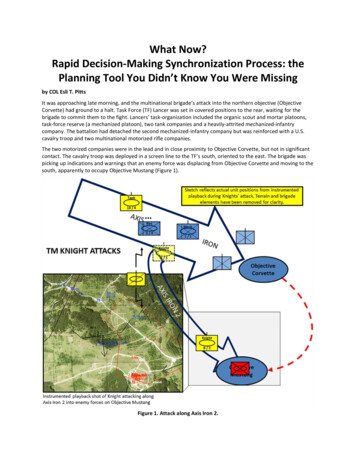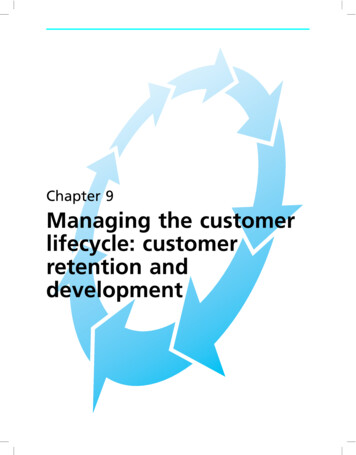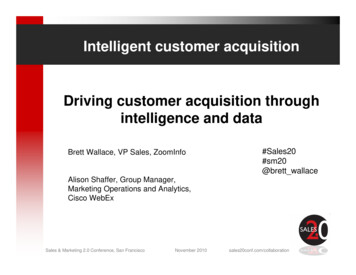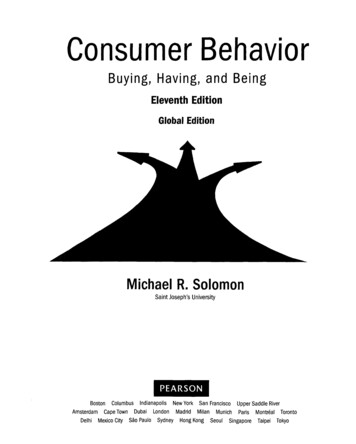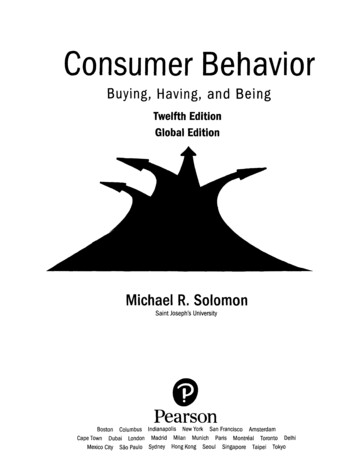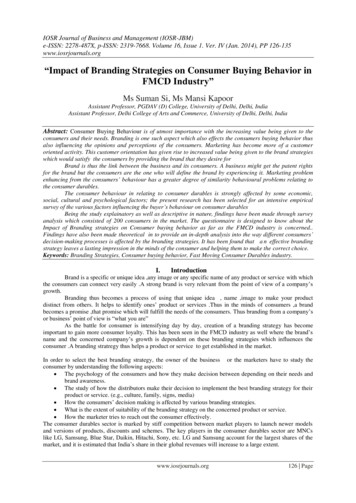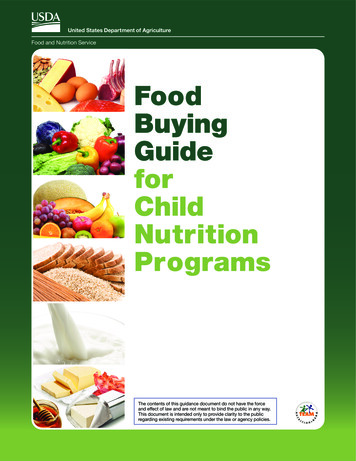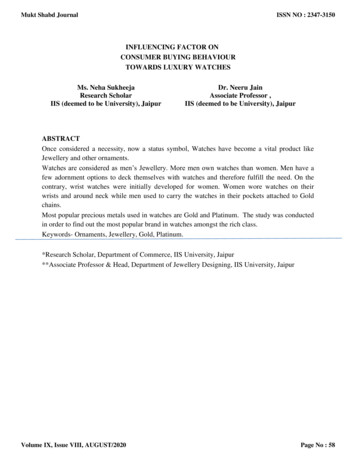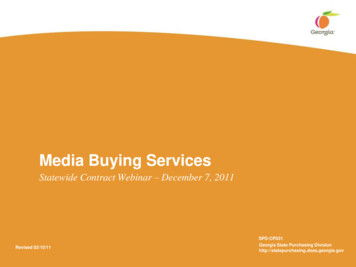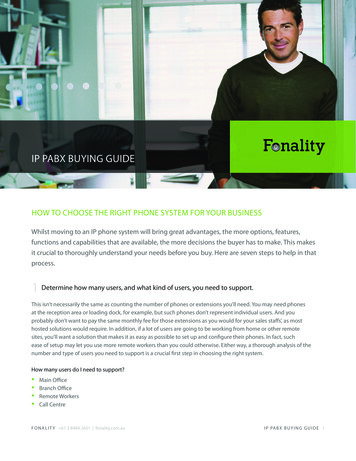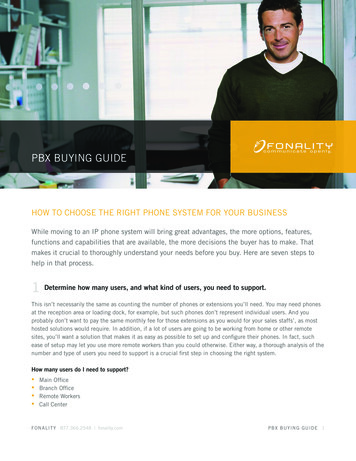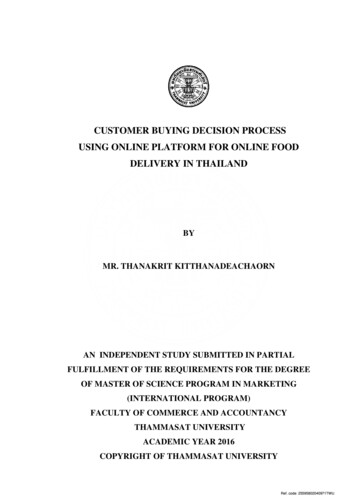
Transcription
CUSTOMER BUYING DECISION PROCESSUSING ONLINE PLATFORM FOR ONLINE FOODDELIVERY IN THAILANDBYMR. THANAKRIT KITTHANADEACHAORNAN INDEPENDENT STUDY SUBMITTED IN PARTIALFULFILLMENT OF THE REQUIREMENTS FOR THE DEGREEOF MASTER OF SCIENCE PROGRAM IN MARKETING(INTERNATIONAL PROGRAM)FACULTY OF COMMERCE AND ACCOUNTANCYTHAMMASAT UNIVERSITYACADEMIC YEAR 2016COPYRIGHT OF THAMMASAT UNIVERSITYRef. code: 25595802040971TWU
CUSTOMER BUYING DECISION PROCESSUSING ONLINE PLATFORM FOR ONLINE FOODDELIVERY IN THAILANDBYMR. THANAKRIT KITTHANADEACHAORNAN INDEPENDENT STUDY SUBMITTED IN PARTIALFULFILLMENT OF THE REQUIREMENTS FOR THE DEGREEOF MASTER OF SCIENCE PROGRAM IN MARKETING(INTERNATIONAL PROGRAM)FACULTY OF COMMERCE AND ACCOUNTANCYTHAMMASAT UNIVERSITYACADEMIC YEAR 2016COPYRIGHT OF THAMMASAT UNIVERSITYRef. code: 25595802040971TWU
(1)Independent Study TitleCUSTOMER BUYING DECISION PROCESSUSING ONLINE PLATFORM FOR ONLINEFOOD DELIVERY IN THAILANDAuthorMr.Thanakrit KitthanadeachakornDegreeMaster of Science Program in Marketing(International Program)Major Field/Faculty/UniversityFaculty of Commerce and AccountancyThammasat UniversityIndependent Study AdvisorProfessor Kenneth E. Miller, Ph.D.Academic Year2016ABSTRACTObjective: The objective of this independent study is to understand theperception of customers toward the online food delivery service as well as explorefactors that could affect consumer decision-making process toward the online fooddelivery service. This research would be beneficial to restaurant owners who wish toestablish a business presence on the online platform.Methodology: This research mainly involved both primary and secondaryresearch. The primary research is consisted of 25 in-depth interviews and 3 focusgroups. The respondents who were interviewed are between 18 to 50 years old andbelong to different Socioeconomic status. The respondents could be divided intocurrent users (i.e., those who have used online food delivery service within the past 3months) and non-users (i.e., those who have never used online food delivery service).Findings: For users, the perception toward the online food delivery service ispositive. They perceive that online food delivery service offers convenience.However, there are some negative feedbacks on the complexity of the online platform.For non-users, they also perceive that online food delivery service offers convenience.However, the reasons they do not use the service are either because of theirRef. code: 25595802040971TWU
(2)limitations on using the system or they cannot justify the perceived risk that areinvolved in ordering food online (i.e., on the quality of food and payment).With regards to the buying process, the process begins with the customersrealizing they do not have time or find it difficult to get food. The customers will thenseek for the information for services that can help them solve the problem. After that,they will match the problem that they have and evaluate the services that are availablein the market. The final stage before purchasing is risk evaluation. If the perceivedrisk is acceptable, they will use the service.Keywords: Online food delivery service, buying decision process.Ref. code: 25595802040971TWU
(3)ACKNOWLEDGEMENTSThis independent study would not have been possible without advice andsupport from many people. First and foremost, I would like to express my deepgratitude to Prof. Ph.D. Kenneth E. Miller for providing me guidance on this project.Many thanks go to my parents for their financial support and understandings; therespondents who made the research possible with their times providing the thoughts,views and opinions; and friends for their advice. Last but not least, I would like tothank the Faculty of Commerce and Accountancy at Thammasat University for givingme the opportunity to study in their postgraduate program.Mr.Thanakrit KitthanadeachakornRef. code: 25595802040971TWU
(4)TABLE OF CONTENTSPageABSTRACT(1)ACKNOWLEDGEMENTS(3)LIST OF TABLES(6)LIST OF FIGURES(7)CHAPTER 1 INTRODUCTION11.1 Background11.2 Research Objective3CHAPTER 2 REVIEW OF LITERATURE42.1 Traditional food delivery industry and online food delivery industry42.2 Consumer behavior in the online food delivery industry52.3 The competition in online food delivery industry52.4 Summary of literature review6CHAPTER 3 RESEARCH METHODOLOGY73.1 Secondary research73.2 Primary research73.3 Data collection93.4 Identification of key research variables103.5 Limitations of the study12Ref. code: 25595802040971TWU
(5)PageCHAPTER 4 RESULTS AND DISCUSSION134.1 Key findings of secondary research134.2 Key findings of primary research: in-depth interview and focus group 144.2.1 Demographic and Social status144.2.2 User respondent’s perception of online platformfor food delivery service154.2.3 Non-user respondent’s perception of online platformfor food delivery service174.2.4 Buying process of online food delivery service18CHAPTER 5 CONCLUSIONS AND RECOMMENDATIONS26REFERENCES29APPENDICESAPPENDIX A: Socioeconomic Status (SES)30APPENDIX B: Sample of in-depth interviewquestions guidelineBIOGRAPHY3135Ref. code: 25595802040971TWU
(6)LIST OF TABLESTables3.1 Respondent profilePage8Ref. code: 25595802040971TWU
(7)LIST OF FIGURESFiguresPage3.1 Research variable concept model114.1 Buying decision process model195.1 Online food delivery buying decision making model265.2 Online food delivery buying process model27Ref. code: 25595802040971TWU
1CHAPTER 1INTRODUCTION1.1Background.In this technology driven age, the Internet has become one of the most powerfulforms of media. As the consumption of traditional media is declining and theconsumption of online media is growing, businesses have to change the way theyoperate. One of the reasons for the growth in consumption of online media is due tothe younger generation. In order to revive from declining sales, many leadingcompanies have started to adopt online business strategies. An example of this is thee-retailing campaign Tesco launched in South Korea in 2015. Customers are able tomake transactions on the virtual online store, allowing Tesco to fulfill and deliver thecustomers’ orders within a few hours. This strategy has led to soaring profitability forTesco, making it the second largest retailer in South Korea.Restaurant businesses have also adopted the online business strategies. There arenow many new restaurant businesses that are selling make to order (MTO) foodwithout having a physical store. These restaurants use the online platform as amedium to communicate with its customers. “JQ Seafood Restaurant” is one of thesuccess stories of a restaurant business that operates without a physical store. Thisunique restaurant sells cooked fresh seafood via Facebook and delivers them tocustomers using motorbikes. JQ Seafood Restaurant has only been in operations for afew years but has had huge success. It is now earning a monthly revenue of 10 millionBaht.The Internet has also provided the same benefits to traditional restaurants toincrease sales. The Internet has also led to the creation of “middlemen” for restaurantbusinesses, such as the food ordering and delivery companies. These middlemenestablish relationships with restaurants and list the partnered restaurants on its onlineplatform (i.e., websites or mobile applications). Customers can then place their orderson the online platform. The income for these middlemen is generated either throughcommission fees from restaurants, delivery fees from customers, or both. The bestRef. code: 25595802040971TWU
2example of this is Foodpanda, an intermediary with a virtual dot com store and mobileapplication. Customers can place their orders online and the food will be delivered totheir requested destinations. Nonetheless, there are requirements set by Foodpandathat the partnered restaurants will be required to meet, such as the food must beprepared within 15 minutes after an order is placed. Foodpanda will handle all thelogistics and payments for the partnered restaurants. Foodpanda earns income throughboth commission fees from restaurants and delivery fees from customers. This newbusiness model has started to gain popularity, as evident by the number of playerstrying to enter the market, such as Line Man and Uber food, whose service will belaunched at the beginning of 2017.The traditional MTO food delivery market is considered as one of the biggestmarkets in the Thai food industry. In 2016, the Thai food delivery industry was worth24,434.4 million Baht (Euromonitor international, 2016). However, the trend isstarting to shift from the traditional food delivery service to the online food deliveryservice. The online MTO food delivery industry had a huge CAGR at 89.7% in 2015(Positioningmag.com, 2015). When the online food delivery industry is fullydeveloped in the coming years, it is possible it will be bigger than the traditional fooddelivery industry. As a result, the traditional MTO food delivery service companiesare starting to adopt online business strategies. For example, The Pizza Hut Company,the largest fast food restaurant chain in Thailand, has introduced dot-com store andmobile application in 2015, as an attempt to increase sales.While the online platform can provide a massive opportunity for the food deliveryindustry, there are several challenges that must be overcome. These include theconsumer perception on short shelf life of food products and the unique buyingprocess of food products where most consumers prefer to see the actual productsbefore making a purchase. This research aims to understand consumer perception andtheir buying processes.The research will compare consumer behavior andperceptions on restaurants, traditional food delivery service and online deliveryservice, in order to identify factors that can influence consumer behavior and craftappropriate marketing strategies for the online food delivery market.Ref. code: 25595802040971TWU
31.2Research ObjectiveThis study will provide restaurant businesses and food delivery businesses witha current or a future online presence a better understanding on the consumerperception and on the characteristics of those who use online food delivery services,in order to be able to identify key success factors to craft the appropriate marketingstrategies. The research objectives are identified as follows:1) To understand consumer perception toward purchasing MTO food via theonline platform2) To understand the buying processes and factors which can influenceconsumers when using online MTO food delivery servicesRef. code: 25595802040971TWU
4CHAPTER 2REVIEW OF LITERATUREThis study is a contemporary topic in applied marketing, which relates to thesubject of society. The information gathered from the literature review will be used as abasis for the analysis and to gain insights into the food delivery industry.This section will be divided into three parts, as follows:2.1 The traditional food delivery industry and the online food delivery industry Consumer behavior in the online food delivery industry The competition in the online food delivery industryTraditional food delivery industry and online food delivery industryThe food market is growing at a maturity rate of 2-4 percent from 2016 to 2017.However, the food delivery market is growing at a CAGR of 11-15 percent from 2016to 2017. The reason of this growth is due to the changes in consumer behavior, wheretime and convenience are highly valued (thansettakij.com, 2016). It is estimated thatthe traditional food delivery market will reach the maturity stage within the next fiveyears. The market is estimated to grow at the rate of 3.5 percent in the next five years.Technological advances in today’s era have provided opportunities for the fooddelivery industry and have reshaped the food delivery industry. In addition,technological advances have changed the behavior of consumers. The online platformallows customers to access multiple restaurants through visiting a single website or asingle mobile application, making it more convenient for consumers. It is possible thisnew change can bring a significant growth to the food delivery market (Sydneymorning herald, 2016).The online MTO food delivery industry had a huge CAGR at 89.7% in 2015(Positioningmag.com, 2015). This shows that the online platform provides a newopportunity for the food delivery market. It is projected that the proportion of onlinefood delivery industry to the entire food delivery industry will jump from 8 percent in2011 to 53 percent in 2019 (mckinsey.com, 2016).Ref. code: 25595802040971TWU
5Based on the interview with Mr. Alexander Felde, the Co-Founder and ManagingDirector of Foodpanda, it was revealed that the online food delivery market hasexpanded by 150 percent in the past 3 years. Foodpanda also revealed that theproportion of Thai customers to total customers expanded from 12 percent in 2012 to56 percent in 2015. This shows the growing number of Thai consumers in the onlinefood delivery market (Manager online, 2015).2.2Consumer behavior in the online food delivery industryMost online food delivery services do not have physical stores. The way thesecompanies communicate with their customers is through the online platform such associal media. Since consumers do not get to see the real products, 58 percent ofconsumers rely on and are enticed by online food pictures, 26 percent prefer onlinereviews and 9 are enticed by video clips posted online (Positioningmag.com, 2016).Based on the survey conducted by EIC on consumers aged between 20 – 40 yearsold, over 20 percent of consumers have purchased food online and half of those do iton a regular basis (i.e., at least once a month). A majority are office workers andbusiness owners. However, some operators only offer their services in Bangkok andmajor cities. Therefore, the researcher suggests that operators expand their area ofservice in order to capture a higher market size (SCB economic in
limitations on using the system or they cannot justify the perceived risk that are involved in ordering food online (i.e., on the quality of food and payment). With regards to the buying process, the process begins with the customers realizing they do not have time or find it di fficult to get food. The customers will then seek for the information for services that can help them solve the .
